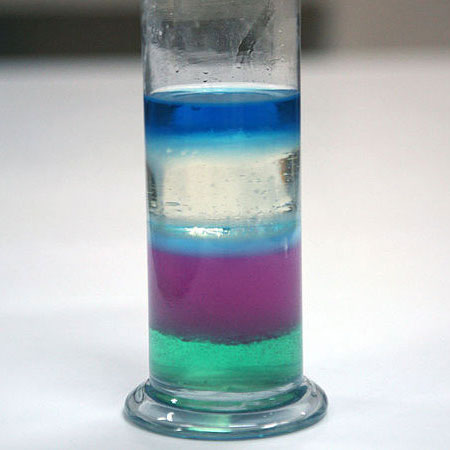You Will Need
Pencil
Paper
Clear glass container
Turkey baster
Honey
Water
Food coloring
Vegetable oil
Other liquids you might like to add:
Corn syrup
Maple syrup
Dish soap
Milk (whole milk is preferred)
Rubbing alcohol
Objects of varying densities such as:
Ping pong ball
Dice
Pony beads
Coins
Metal nuts or bolts
Popcorn kernels
Cherry tomato
Grape
Directions
- Ask your young scientist to rank each liquid based on how dense they think it is. Note their predictions on the paper.
- Carefully add the liquids to the clear container in order of their density.
(NOTE: The following instructions will show you how to add all 8 of the suggested liquids in order. You don’t have to use all 8, just use what you have available. You can also let your scientist put them in the order they predicted, but if any are out of order, it may take some time for the liquids to settle into their own layers.)- First add the honey to the bottom of the clear container, being careful not to get it stuck on the sides as it is poured.
- Then slowly pour the corn syrup on top of the honey, again being careful not to get it stuck on the side of the container.
- Then slowly pour the maple syrup on top of the corn syrup, also being careful not to get any stuck on the side of the container.
- Next, add the milk. It’s easiest to use a turkey baster to slowly drop the milk on top of the maple syrup. Try to keep the baster above the center of the container for best results.
- Next is the dish soap layer. Also use the turkey baster to slowly drop the soap on top of the milk, trying to keep the baster near the center of the container.
- The next layer is colored water. Add a few drops of food coloring to your water and mix it together before adding this layer to the density tower. Using the turkey baster, put the tip against the side of the container to let the water pool on top of the dish soap.
- Next, is the vegetable oil. Also use the turkey baster tip on the side of the container trick for this liquid.
- Last is the rubbing alcohol. Mix in a few drops of a different food coloring to differentiate it from the other layers. Use the turkey baster to slowly let the liquid flow down the inside of the container to make the final layer.
- Have your scientist review their predicted order of the layers. Did the actual order surprise them at all? Why or why not? What do they observe about each layer?
- Now gather your sink or float objects. Have your scientist predict which objects they think will sink or float on each layer. Write down the predictions on the paper.
- Now the magic happens! Slowly drop your objects into the density tower. Which items sink to the bottom? Which items stay on the top? Experiment!
How it works
Objects will sink or float depending on their density as it relates to the layers in the tower.
A metal bolt has more density than any of the liquids, so it sinks all the way to the bottom. A ping pong ball has less density than even the rubbing alcohol, so it stays afloat right on top. The other items will settle in at various layers according to their density. The cherry tomato usually lands in the dish soap, and the popcorn kernels usually end up the maple or corn syrup.
Items may vary depending on their density, and on the density of the liquid you used (if you used skim milk instead of whole milk, for example, your layers may end up in a slightly different order.)
Key Words
- Sink
- To go below the surface of the water
- Float
- To stay on or above the surface of the water
- Observing
- Using our senses to gather information
- Density
- How compact the molecules of an object are
- Buoyancy
- The upward force of an object that is produced by the fluid or air that object is placed in

